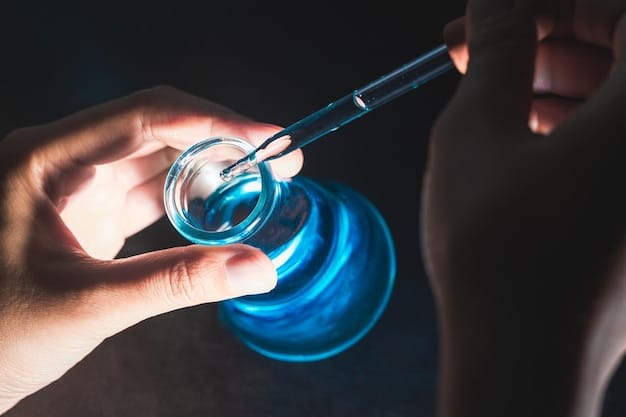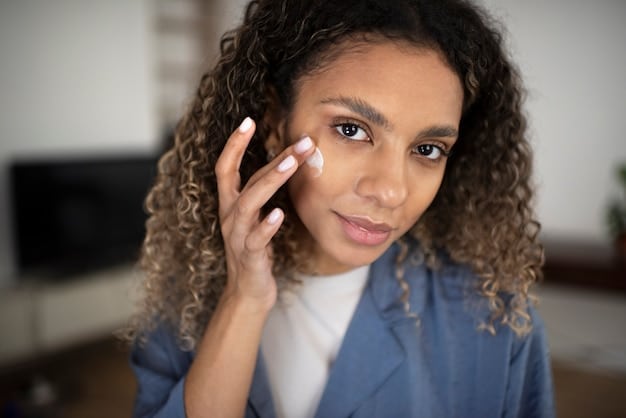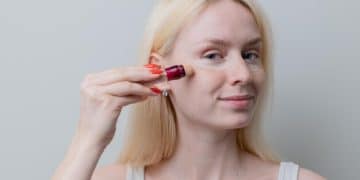Dark spot correctors: fade hyperpigmentation by 50% with proven ingredients

Anúncios
Dark spot correctors containing potent ingredients like hydroquinone, vitamin C, and niacinamide are clinically effective at reducing hyperpigmentation by up to 50% through mechanisms that inhibit melanin production and promote cell turnover, leading to a more even skin tone.
Are you looking for solutions to diminish stubborn dark spots and achieve a more even complexion? Exploring Dark Spot Correctors: Fade Hyperpigmentation by 50% with These Proven Ingredients offers a beacon of hope for many seeking clearer skin.
Anúncios
Understanding hyperpigmentation and its impact
Hyperpigmentation is a common skin condition characterized by the darkening of skin areas due to an overproduction of melanin, the pigment responsible for skin, hair, and eye color. This excess melanin can manifest in various forms, including sun spots, age spots, post-inflammatory hyperpigmentation (PIH), and melasma. While generally harmless, hyperpigmentation can significantly impact an individual’s self-esteem and overall perception of their skin’s appearance, often leading to a desire for effective treatment.
The causes of hyperpigmentation are diverse, ranging from sun exposure and hormonal fluctuations to skin inflammation and certain medications. Sunlight, particularly UV radiation, is a primary trigger, stimulating melanocytes (melanin-producing cells) to create more pigment as a protective mechanism. Hormonal changes, common during pregnancy or when taking oral contraceptives, can lead to melasma, often referred to as the “mask of pregnancy.” Post-inflammatory hyperpigmentation typically occurs after skin injuries like acne breakouts, eczema, or even minor cuts, where the healing process leaves behind a dark mark.
The science behind hyperpigmentation
At a cellular level, hyperpigmentation involves complex biological pathways. Melanin synthesis, known as melanogenesis, is a multi-step process initiated by an enzyme called tyrosinase. This enzyme catalyzes the oxidation of tyrosine, an amino acid, leading to the formation of various melanin pigments. When this process becomes dysregulated or overstimulated, excessive melanin is produced and deposited in the epidermis or dermis, resulting in visible dark spots.
Anúncios
- Melanin production: Triggered by UV exposure or inflammation, melanocytes become overactive.
- Tyrosinase activity: This key enzyme directly influences the amount of melanin produced.
- Pigment deposition: Excess melanin is deposited, creating visible dark spots.
Understanding these underlying mechanisms is crucial for developing effective dark spot correctors. The most successful ingredients work by targeting one or more steps in the melanogenesis pathway, either by inhibiting tyrosinase, preventing melanin transfer, or promoting exfoliation to remove pigmented cells. This scientific approach allows for targeted treatments that can significantly reduce the appearance of hyperpigmentation, often by a substantial percentage, leading to noticeable improvements in skin clarity and uniformity.
Beyond the aesthetic concerns, addressing hyperpigmentation can contribute to overall skin health by encouraging a more consistent cell turnover and protecting skin from further damage. Effective treatment plans often combine topical correctors with sun protection measures, recognizing that prevention is as vital as active treatment in maintaining an even skin tone.
Hydroquinone: the gold standard for pigment reduction
Hydroquinone has long been considered the leading ingredient in the treatment of hyperpigmentation. Its efficacy lies in its ability to inhibit tyrosinase, a critical enzyme involved in melanin production. By blocking this enzyme, hydroquinone effectively reduces the formation of new melanin, leading to a lightening of existing dark spots and preventing new ones from forming. This powerful depigmenting agent has been widely studied and proven to deliver significant results in reducing various forms of hyperpigmentation, including melasma, sun spots, and post-inflammatory hyperpigmentation.
Typically available in concentrations ranging from 2% over-the-counter to 4% or higher by prescription, hydroquinone’s mechanism of action involves the suppression of melanocyte metabolic processes and an increase in the degradation of melanosomes, which are the organelles responsible for synthesizing and storing melanin. This dual action makes it exceptionally effective at diminishing the appearance of stubborn dark patches, often achieving visible lightening within weeks of consistent use.
Using hydroquinone safely and effectively
Despite its proven efficacy, hydroquinone requires careful use due to its potent nature. Side effects can include skin irritation, redness, and dryness, especially during the initial stages of treatment. Long-term, continuous use of high concentrations without medical supervision can lead to a condition called ochronosis, a permanent bluish-black discoloration of the skin, though this is rare and primarily associated with misuse or prolonged use of formulations not approved for the market.
- Patch testing: Always perform a patch test before full application to check for adverse reactions.
- Short-term use: Hydroquinone is best used in cycles, typically for 3-4 months, followed by a break to prevent potential side effects and allow the skin some recovery time.
- Sun protection: Strict sun avoidance and daily application of broad-spectrum SPF are non-negotiable when using hydroquinone, as sun exposure can reverse its effects and worsen hyperpigmentation.
Consulting a dermatologist before starting hydroquinone treatment is highly recommended, particularly for prescription strengths. A specialist can assess your skin condition, recommend the appropriate concentration, and guide you on the proper application and cycling schedule to maximize benefits while minimizing risks. They can also advise on combining hydroquinone with other active ingredients to enhance results and maintain skin clarity after the treatment cycle ends. This professional guidance ensures that hydroquinone is utilized as a safe and effective component of a comprehensive hyperpigmentation management plan.

Vitamin C: antioxidant power for brightening
Vitamin C, also known as L-ascorbic acid, is celebrated in skincare for its powerful antioxidant properties and its significant role in brightening the complexion. When it comes to hyperpigmentation, vitamin C works by inhibiting tyrosinase, similar to hydroquinone, though typically with a milder effect. It also acts as a potent antioxidant, neutralizing free radicals caused by UV exposure and environmental pollutants, which can otherwise trigger melanin production and contribute to dark spots. This dual action makes vitamin C an indispensable ingredient in many dark spot correctors, offering both preventative and corrective benefits.
Beyond its pigment-reducing capabilities, vitamin C is crucial for collagen synthesis, helping to improve skin elasticity and firmness. Its anti-inflammatory properties can also aid in reducing redness and soothing irritated skin, making it beneficial for those with post-inflammatory hyperpigmentation. Due to its stability challenges, choosing a formulation that protects the vitamin C from oxidation, such as dark bottles or airless pumps, is essential to ensure its potency and effectiveness.
Maximizing vitamin C’s benefits
For optimal results, incorporating a stable form of vitamin C into your daily skincare routine is key. Serums often provide the highest concentration and best absorption. While vitamin C is generally well-tolerated, some individuals might experience mild tingling or irritation, especially when first introducing it to their routine. Starting with a lower concentration and gradually increasing it can help the skin adapt.
- Daytime use: Applying vitamin C in the morning, under sunscreen, enhances its protective benefits against UV damage.
- Combination therapy: It pairs well with other active ingredients like retinoids or alpha hydroxy acids, provided they are introduced gradually to avoid irritation.
- Consistency: Regular, long-term use is necessary to see the full brightening and corrective effects of vitamin C.
The brightening effect of vitamin C is often attributed to reduced melanin production and general enhancement of skin radiance. While it might not deliver the same rapid and dramatic results as hydroquinone for severe hyperpigmentation, its gentler nature makes it suitable for prolonged use and for individuals seeking a more gradual and comprehensive improvement in skin tone and texture. It acts as an excellent complementary ingredient in a multi-pronged approach to achieving an even and luminous complexion.
Niacinamide: versatile skin brightener and barrier supporter
Niacinamide, a form of vitamin B3, is a versatile ingredient renowned for its multifaceted benefits in skincare, particularly in addressing hyperpigmentation. Unlike hydroquinone and vitamin C, niacinamide does not directly inhibit tyrosinase activity. Instead, its primary mechanism for dark spot correction involves inhibiting the transfer of melanosomes from melanocytes to keratinocytes, the surface skin cells. By preventing this transfer, it effectively stops the melanin from reaching the skin’s surface where it becomes visible as dark spots.
This unique mode of action makes niacinamide an excellent adjunct to other pigment-reducing ingredients, as it targets a different step in the melanin pathway. Beyond its role in hyperpigmentation, niacinamide improves skin barrier function, reduces inflammation and redness, minimizes the appearance of pores, and regulates oil production. These comprehensive benefits contribute to an overall healthier and more even-toned complexion, making it suitable for almost all skin types, including sensitive and acne-prone skin.
Integrating niacinamide into your routine
Niacinamide is well-tolerated and can be easily incorporated into both morning and evening skincare routines. It is available in various concentrations, commonly ranging from 2% to 10% in serums, moisturizers, and toners. Starting with a lower concentration and observing how your skin reacts is always a good practice, although adverse reactions are rare.
- Compatibility: Niacinamide can be safely used alongside most other active ingredients, including retinoids, vitamin C, and alpha hydroxy acids, without concerns about inactivation or increased irritation.
- Barrier support: Its ability to strengthen the skin barrier makes it particularly beneficial for individuals whose hyperpigmentation is often accompanied by compromised skin, such as those with eczema or post-acne marks.
- Consistent application: Like all skincare ingredients, consistent daily use is crucial for visible results, which typically manifest over several weeks to months.
The gentle yet potent nature of niacinamide makes it a popular choice for long-term use in managing hyperpigmentation and maintaining overall skin health. Its ability to improve various aspects of skin function while directly contributing to a more even skin tone positions it as a key player in the next generation of dark spot correctors, offering a broad spectrum of benefits beyond just pigmentation correction.
Alpha hydroxy acids (AHAs) and beta hydroxy acids (BHAs) for exfoliation
Alpha Hydroxy Acids (AHAs) and Beta Hydroxy Acids (BHAs) are chemical exfoliants widely used in skincare to improve skin texture, clarity, and tone. Their role in treating hyperpigmentation stems from their ability to accelerate cell turnover, helping to shed dark, pigmented cells from the surface of the skin. This process reveals fresher, less pigmented skin underneath, gradually reducing the visibility of dark spots and promoting a more even complexion. AHAs, such as glycolic acid and lactic acid, are water-soluble and work primarily on the skin’s surface, making them ideal for sun damage and superficial hyperpigmentation. BHAs, notably salicylic acid, are oil-soluble, allowing them to penetrate deeper into pores and exfoliate from within, making them particularly effective for post-inflammatory hyperpigmentation associated with acne.
Regular use of these acids can also enhance the penetration and efficacy of other active ingredients by removing the outer layer of dead skin cells that might otherwise act as a barrier. While effective, it’s important to use AHAs and BHAs cautiously, as over-exfoliation can lead to irritation, increased photosensitivity, and potentially worsen hyperpigmentation if proper sun protection is not rigorously maintained.
Optimal use of AHAs and BHAs
Choosing between AHAs and BHAs, or incorporating both, depends on individual skin type and the specific concerns. For general skin brightening and surface hyperpigmentation, AHAs are often recommended. For acne-prone skin with existing dark marks, BHAs can be more beneficial due to their ability to address both the breakouts and the subsequent hyperpigmentation. Starting with lower concentrations and gradually increasing frequency can help the skin adapt and minimize irritation.
- Photosensitivity: Both AHAs and BHAs increase skin’s sensitivity to the sun, making broad-spectrum SPF a non-negotiable daily essential.
- Frequency of use: Depending on skin tolerance, these acids can be used a few times a week or daily.
- Layering: When combining with other actives, introduce them slowly and consider alternating nights to avoid overwhelming the skin.
While AHAs and BHAs primarily work through exfoliation rather than direct melanin inhibition, their contribution to fading hyperpigmentation is significant. They are particularly effective when used in conjunction with ingredients that target melanin production, creating a comprehensive approach to achieving a clearer and more uniform skin tone. The key is finding the right balance and consistency to harness their benefits without compromising skin barrier integrity.
Retinoids: powerful cell turnover enhancers
Retinoids, derivatives of vitamin A, are among the most powerful and well-researched ingredients in dermatology for various skin concerns, including hyperpigmentation. Tretinoin (prescription-strength retinoid) and retinol (over-the-counter) work by significantly accelerating skin cell turnover, which helps to shed dark, pigmented cells more rapidly. This increased exfoliation not only reduces the appearance of existing dark spots but also aids in preventing new ones by promoting a healthier, more organized cellular renewal process. Retinoids also interfere with the transfer of melanin to surface skin cells and possess anti-inflammatory properties, making them beneficial for post-inflammatory hyperpigmentation.
Beyond their role in pigmentation, retinoids are celebrated for their anti-aging benefits, stimulating collagen production and reducing fine lines and wrinkles. Their comprehensive effects often lead to a smoother texture, improved skin elasticity, and a more radiant complexion. However, their potency means careful introduction and consistent use are necessary to mitigate potential side effects such as redness, peeling, and dryness, commonly known as the “retinization” period.
Navigating retinoid use
Introducing retinoids into a skincare routine requires patience and a gradual approach. Starting with a low concentration (e.g., 0.25% retinol) a few times a week and slowly increasing frequency and concentration as skin tolerates is recommended. Ointments or creams are often less irritating than gels or serums for beginners. Always apply retinoids in the evening, as they can degrade in sunlight and increase photosensitivity.
- Nighttime application: Retinoids are best applied at night to maximize their efficacy and minimize sun sensitivity.
- Moisturizer sandwich: Applying a layer of moisturizer before and after your retinoid can help buffer its effects and reduce irritation.
- Sun protection: Daily, rigorous use of broad-spectrum sunscreen with an SPF of 30 or higher is absolutely essential when using retinoids to prevent sun damage and worsening hyperpigmentation.
While the initial adjustment period can be challenging, the long-term benefits of retinoids for hyperpigmentation and overall skin health are substantial. They are often considered a cornerstone of effective dark spot correction regimens, particularly when combined with ingredients like vitamin C or hydroquinone under professional guidance. The consistent application of these powerful compounds can lead to a significant reduction in hyperpigmentation and a noticeably improved skin texture and tone over time.

Kojic acid and arbutin: natural tyrosinase inhibitors
Kojic acid and arbutin are two naturally derived ingredients that have gained popularity in dark spot correctors for their ability to effectively diminish hyperpigmentation. Both operate primarily by inhibiting tyrosinase, the enzyme central to melanin production. Kojic acid is derived from fungi and is often found in fermented foods like sake and soy sauce. It works by chelating copper at the active site of tyrosinase, thereby preventing the enzyme from initiating melanin synthesis. This mechanism makes it a powerful agent for lightening existing dark spots and evening out skin tone.
Arbutin, on the other hand, is a glycosylated hydroquinone found in fruits like bearberry, pear, and certain cereals. It acts as a stable and gentler derivative of hydroquinone, slowly releasing hydroquinone in the skin to inhibit tyrosinase. This controlled release mechanism makes arbutin a less irritating alternative to hydroquinone, suitable for those with sensitive skin who may not tolerate stronger depigmenting agents. Both ingredients are valued for their targeted action on melanin production, offering a more natural approach to pigment reduction.
Integrating these botanicals into your routine
Products containing kojic acid and arbutin are generally well-tolerated, making them excellent choices for daily use. Kojic acid can sometimes cause mild irritation or allergic reactions in sensitive individuals, so a patch test is advisable. Arbutin, being a gentler derivative, is less likely to cause irritation, making it a preferred choice for sustained use.
- Combine with antioxidants: Pairing kojic acid or arbutin with antioxidants like ferulic acid or vitamin E can enhance their stability and efficacy.
- Consistent application: Like most dark spot correctors, visible results require consistent daily usage over several weeks to months.
- Sun protection: Always use a broad-spectrum SPF when incorporating these ingredients into your routine, as new sun exposure can counteract their lightening effects.
The beauty of kojic acid and arbutin lies in their efficacy as tyrosinase inhibitors combined with their relatively mild profiles compared to some stronger agents. They are often found in formulations designed for long-term maintenance after more intensive treatments or as standalone options for milder hyperpigmentation. Their natural origins also appeal to consumers seeking plant-derived alternatives for their skincare needs, proving that effective dark spot correction can be achieved through a variety of scientifically sound pathways.
Integrated approach: combining active ingredients for synergy
While individual ingredients like hydroquinone, vitamin C, niacinamide, retinoids, AHAs, BHAs, kojic acid, and arbutin are effective on their own, the most significant improvements in hyperpigmentation often come from a multi-modal approach. Combining these active ingredients leverages their synergistic effects, targeting different steps in the melanin production pathway and exfoliation process. This strategic combination can lead to faster and more substantial results, sometimes fading hyperpigmentation by 50% or more, while also minimizing potential side effects by using lower concentrations of individual potent ingredients.
For instance, a regimen might involve using a retinoid at night to boost cell turnover and inhibit melanin transfer, followed by a vitamin C serum in the morning for antioxidant protection and additional brightening. Incorporating niacinamide can further enhance barrier function and reduce inflammation, creating a healthier environment for pigmentation to resolve. Hydroquinone, when used, is typically cycled with other depigmenting agents to prevent resistance and reduce the risk of adverse effects. The key is to create a balanced routine that addresses the various facets of hyperpigmentation without overwhelming the skin.
Designing your custom dark spot regimen
Crafting an effective dark spot correction regimen should be a thoughtful process, ideally guided by a dermatologist, especially for severe hyperpigmentation or sensitive skin. A professional can help identify the root cause of your hyperpigmentation and recommend the most suitable combination of ingredients and delivery methods.
- Identify primary culprits: Understand what type of hyperpigmentation you have (sun spots, melasma, PIH) to select the most targeted ingredients.
- Start slowly: Introduce one new active ingredient at a time to allow your skin to adjust and to identify any potential sensitivities.
- Consistency is key: Daily, consistent application over several months is essential for seeing significant and lasting results.
- Sun protection: This remains the single most important step in any hyperpigmentation treatment plan. Daily broad-spectrum SPF 30+ is non-negotiable.
An integrated approach allows for a more comprehensive attack on hyperpigmentation, from disrupting melanin synthesis to accelerating the removal of already pigmented cells. This strategy not only improves cosmetic appearance but also contributes to overall skin health and resilience against future hyperpigmentation. By understanding the roles of various proven ingredients and how to combine them effectively, individuals can achieve remarkable improvements in skin clarity and tone, leading to a visibly brighter and more even complexion.
| Key Ingredient | Primary Action against Dark Spots |
|---|---|
| ✨ Hydroquinone | Directly inhibits tyrosinase for melanin reduction. |
| 🍊 Vitamin C | Antioxidant; mild tyrosinase inhibitor, brightens skin. |
| 🛡️ Niacinamide | Blocks melanosome transfer, reduces inflammation. |
| 🌟 Retinoids | Accelerates cell turnover, inhibits melanin transfer. |
Frequently Asked Questions about Dark Spot Correctors
Visible results from dark spot correctors can vary significantly depending on the severity of the hyperpigmentation, the specific ingredients used, and individual skin type. Generally, consistent use for 8 to 12 weeks is required to notice significant improvement. More stubborn spots or melasma may take several months or longer to show optimal results, emphasizing the importance of patience and consistent application.
Combining multiple dark spot correctors can be effective as different ingredients target various pathways of melanin production. However, it’s crucial to do so cautiously to avoid irritation. Start by introducing one new product at a time and observe your skin’s reaction. Consulting a dermatologist is highly recommended to safely strategize combining ingredients like hydroquinone, retinoids, and vitamin C for synergistic effects.
Absolutely. Sun protection is the most critical step when using dark spot correctors. UV radiation is a primary trigger for hyperpigmentation, and exposing treated skin to the sun can reverse the effects of correctors and even worsen existing dark spots. Daily application of a broad-spectrum sunscreen with SPF 30 or higher, even on cloudy days, is non-negotiable for effective treatment and prevention.
Potential side effects vary by ingredient. Potent ingredients like hydroquinone and retinoids can cause redness, dryness, peeling, or irritation, especially during initial use. Milder ingredients like niacinamide or arbutin are generally well-tolerated. Always perform a patch test before full application, and if irritation persists, reduce usage frequency or consult a dermatologist. Long-term misuse of certain ingredients can lead to other skin issues.
While dark spot correctors can significantly fade hyperpigmentation, often by 50% or more, achieving complete removal can be challenging, especially for deep-seated or long-standing spots like melasma. These products aim to reduce the appearance and intensity of dark marks, leading to a more even and brighter skin tone. Continuous maintenance and strict sun protection are often required to prevent recurrence and maintain results.
Conclusion
Addressing hyperpigmentation is a journey that benefits immensely from a strategic and informed approach. The efficacy of Dark Spot Correctors: Fade Hyperpigmentation by 50% with These Proven Ingredients is well-documented, offering real hope for those seeking a more uniform complexion. Whether opting for the potent action of hydroquinone, the antioxidant benefits of vitamin C, the gentle versatility of niacinamide, the exfoliating power of AHAs and BHAs, or the cell-renewing effects of retinoids, each ingredient plays a crucial role in reducing melanin production or accelerating its removal. The key to success often lies in understanding how these ingredients work, carefully integrating them into a consistent routine, and, perhaps most importantly, embracing rigorous sun protection. By doing so, individuals can significantly diminish the visibility of dark spots, revealing a brighter, more confident self through clearer, more radiant skin.





